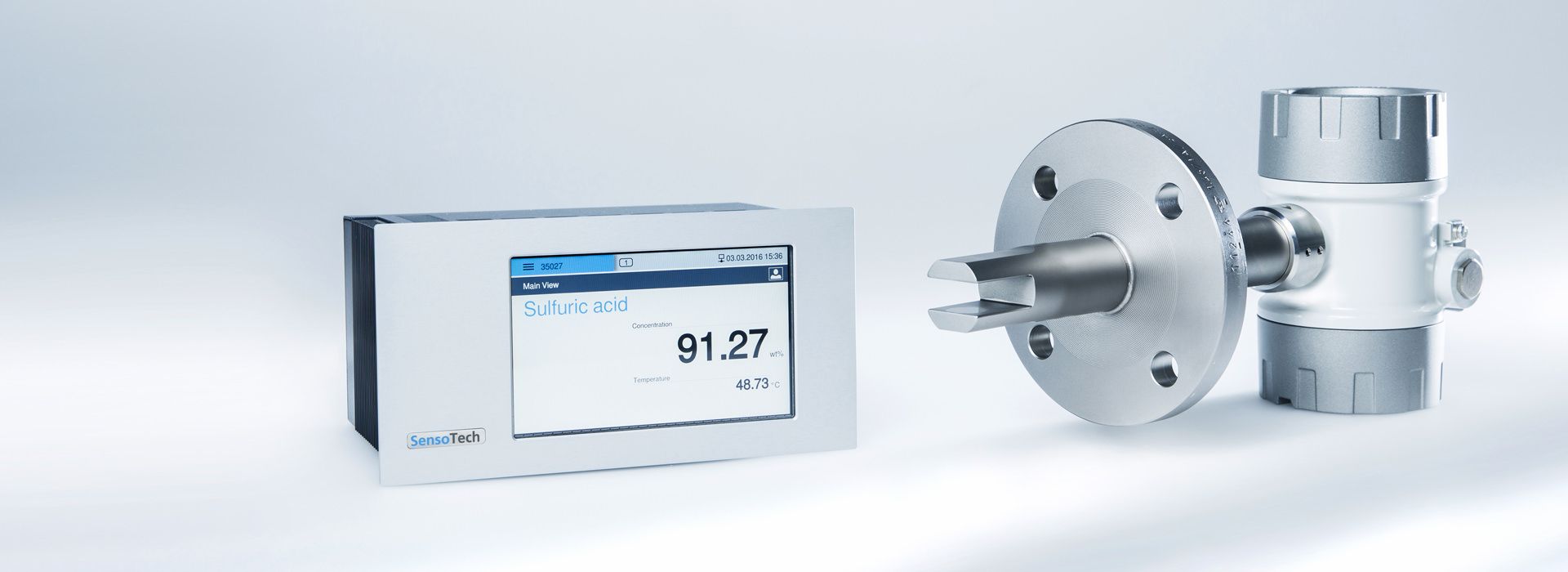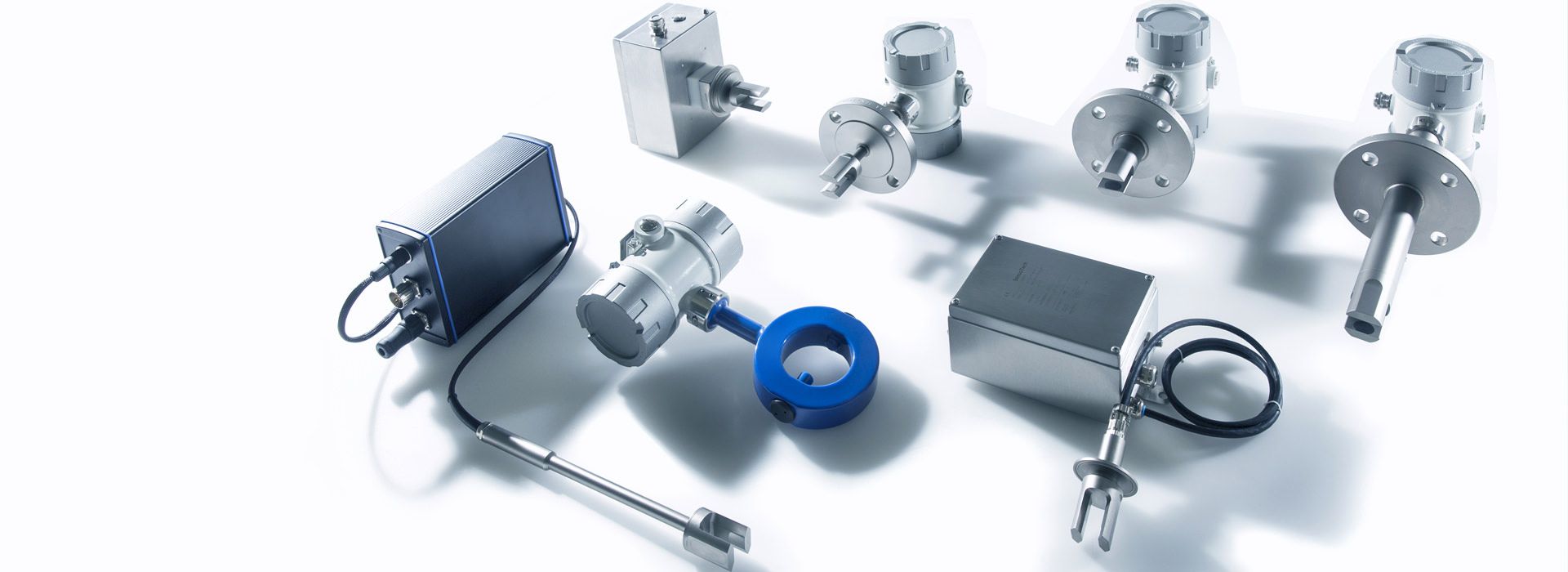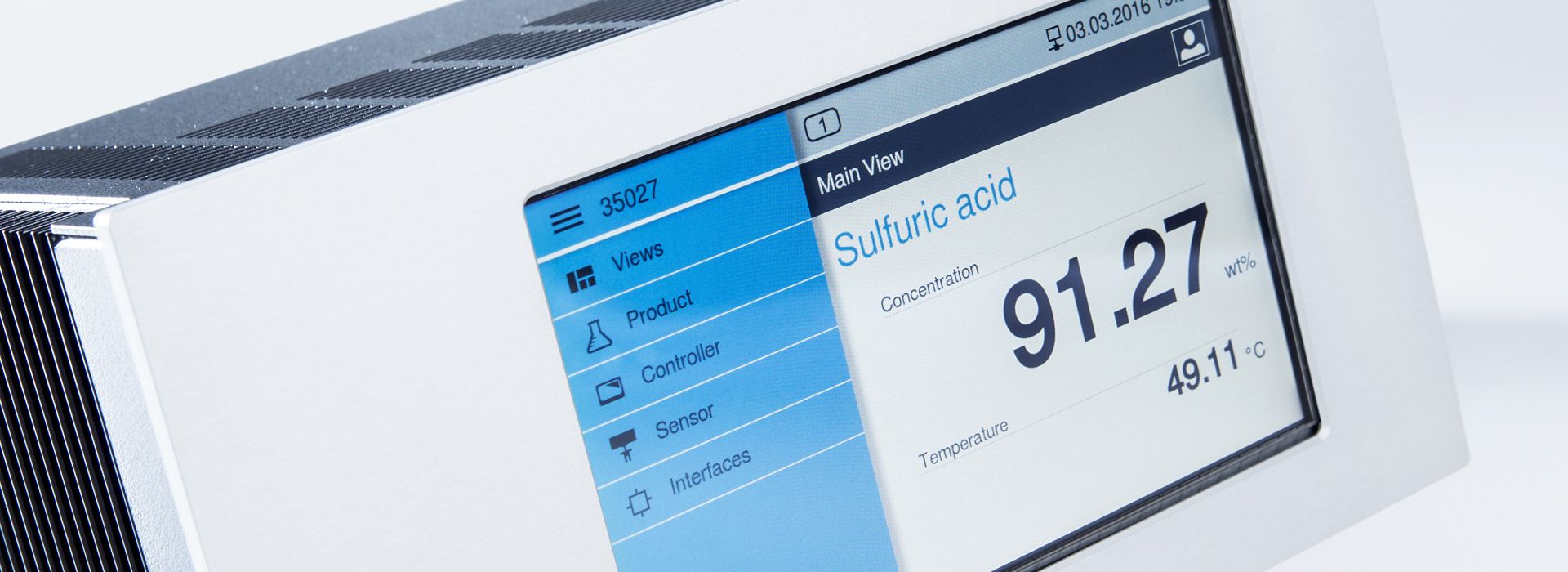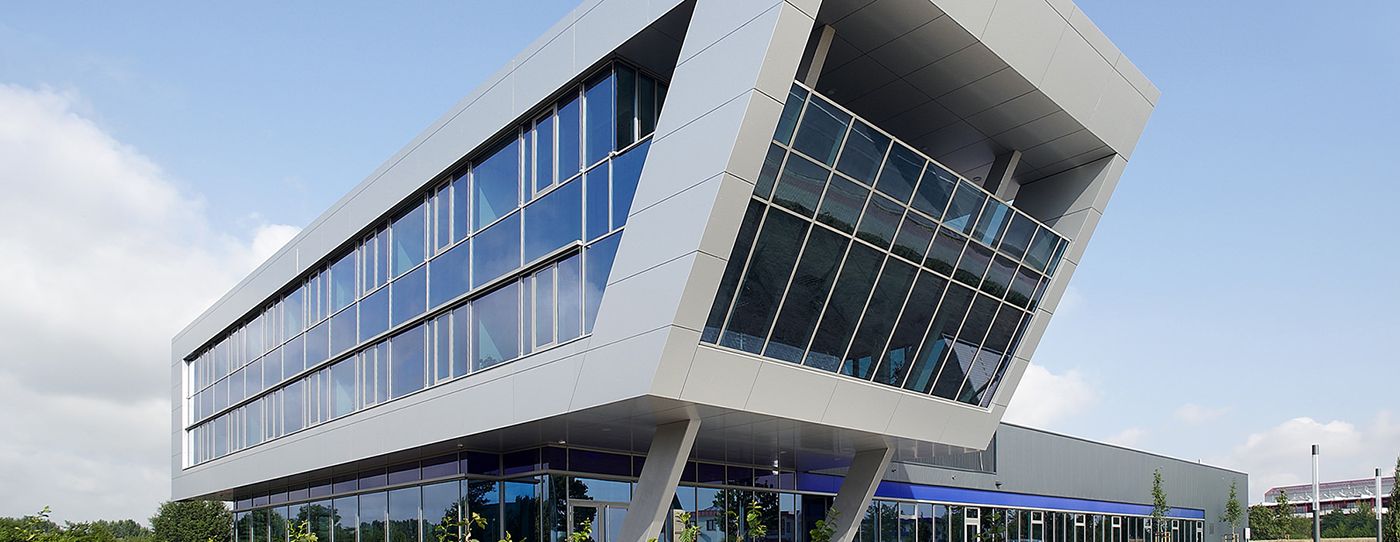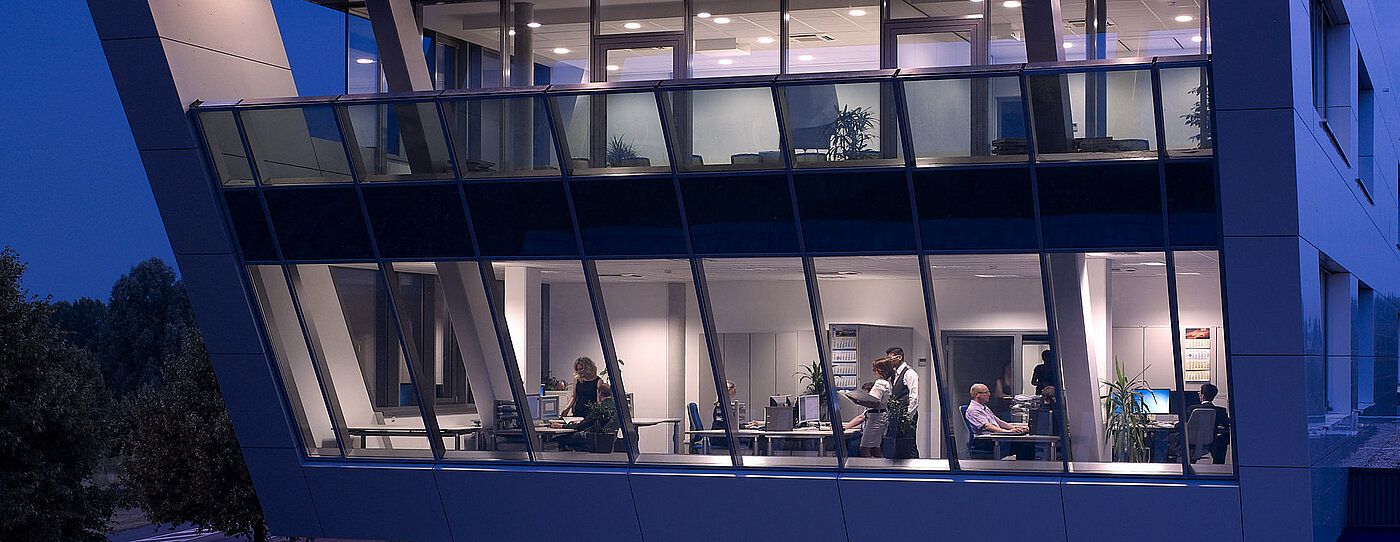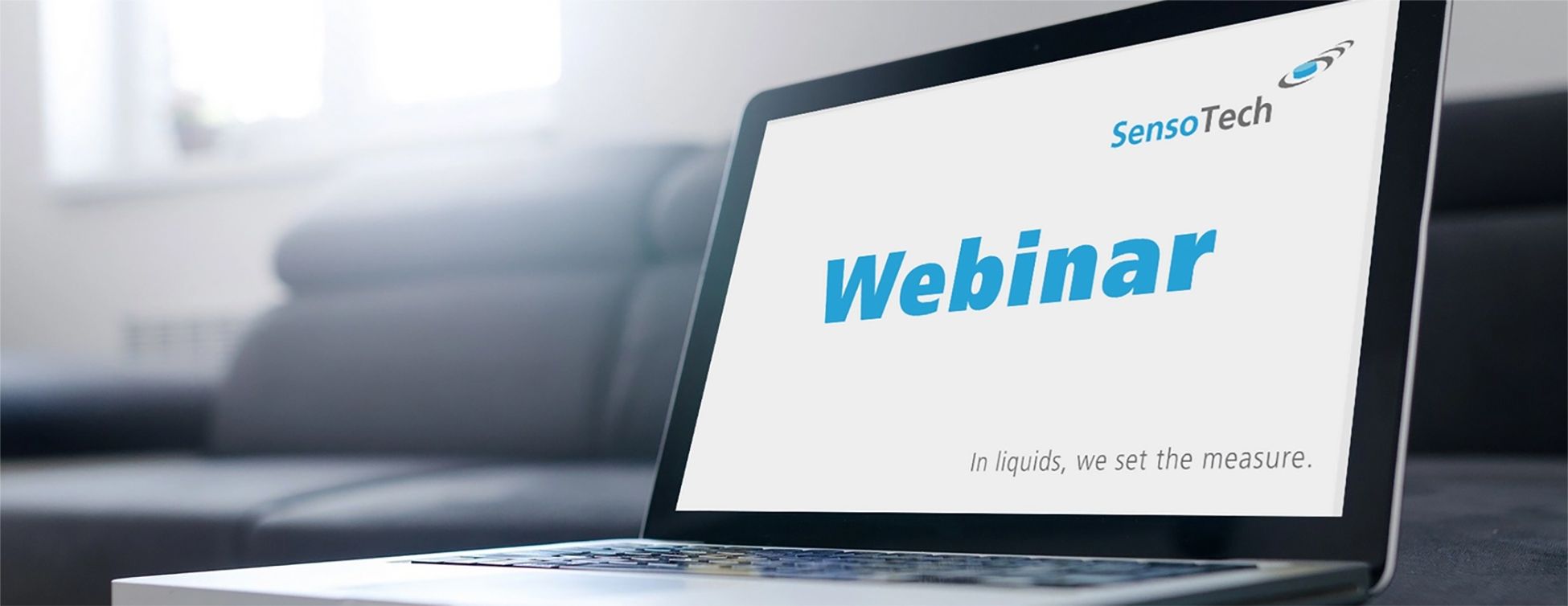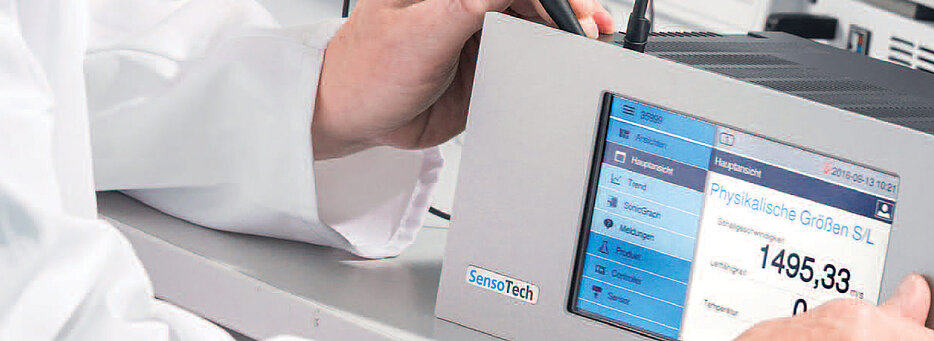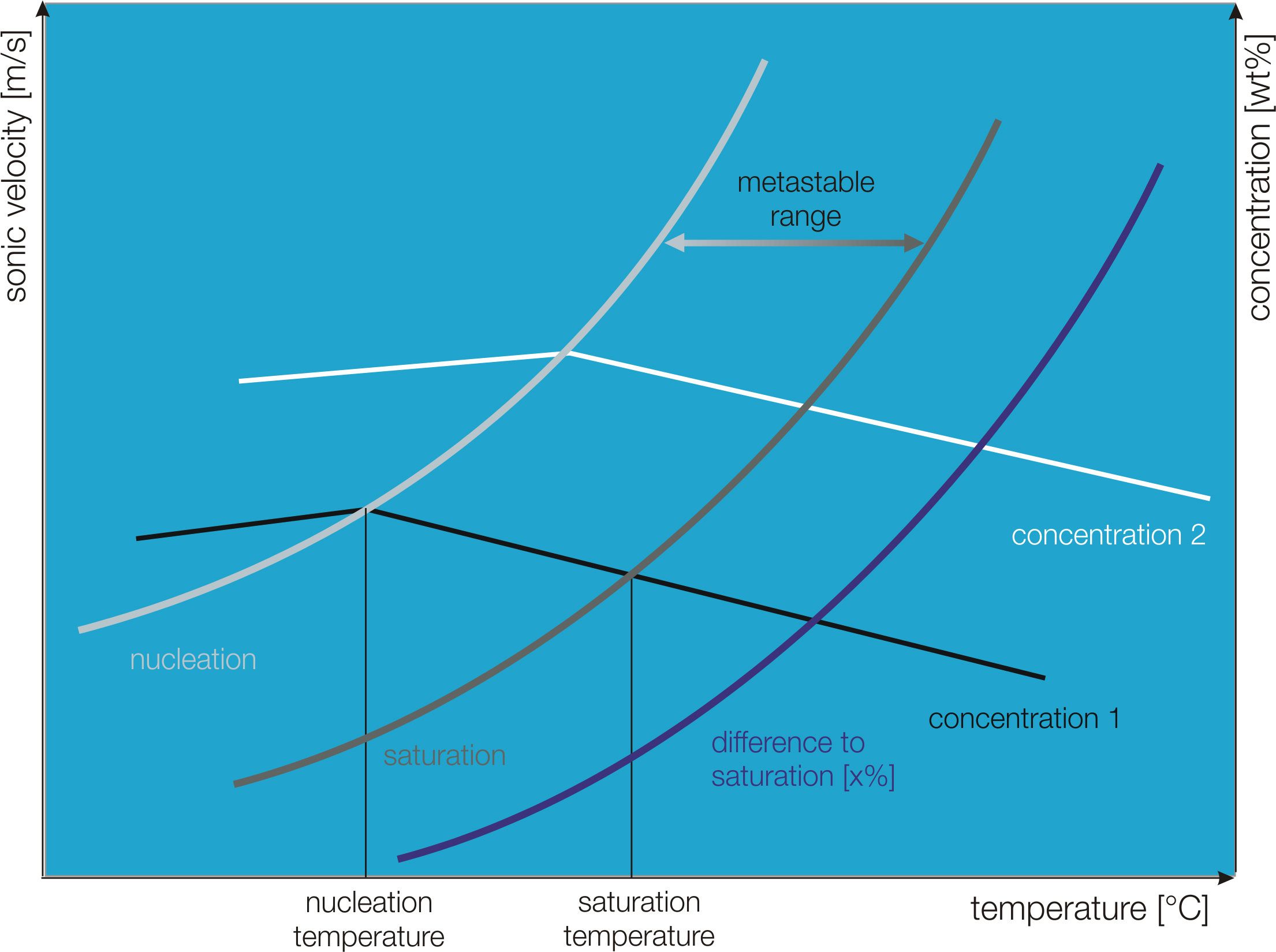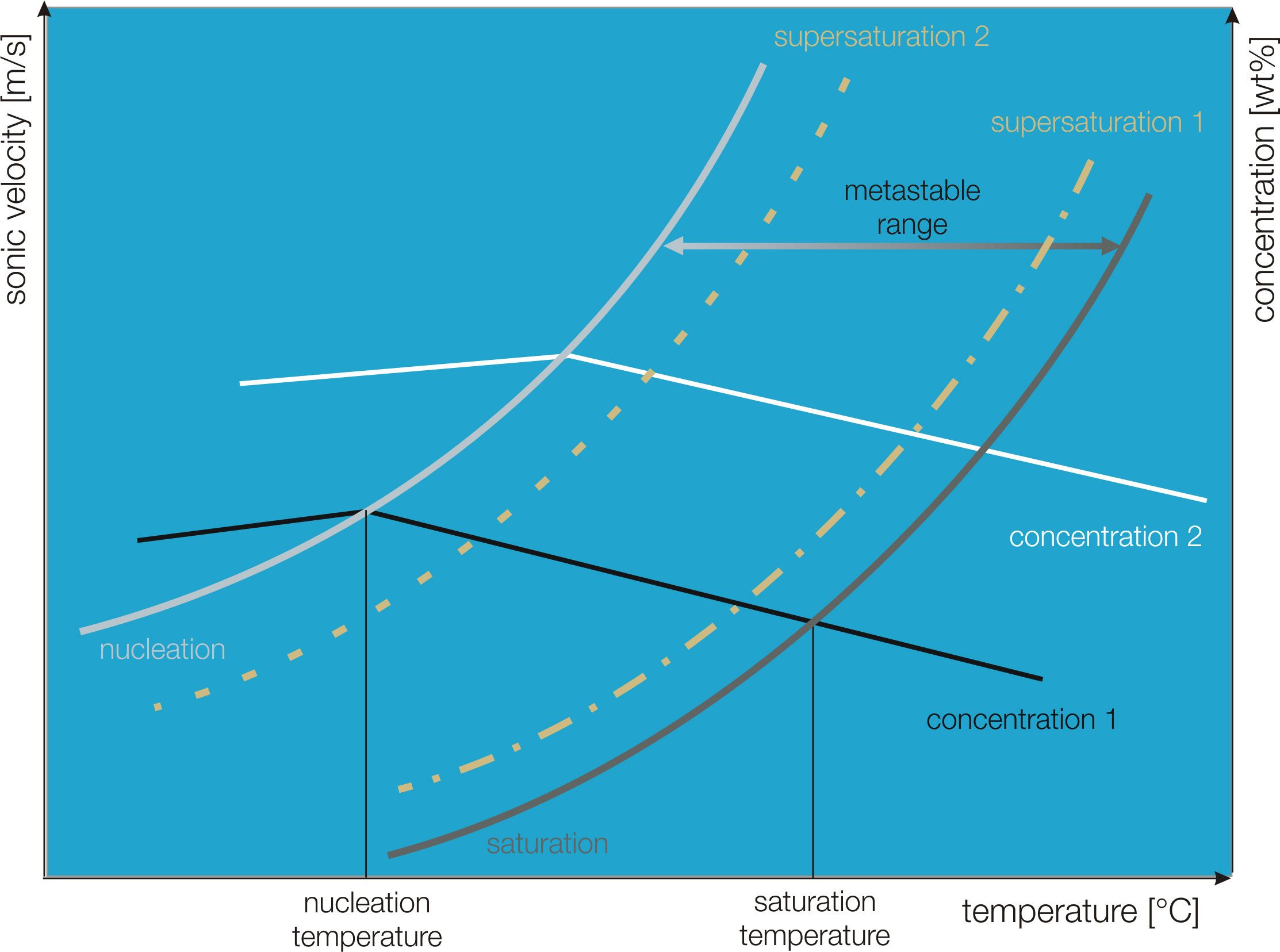Crystallization monitoring
The device is based on the highly precise measurement of the absolute sound velocity and process temperature, allowing the tracking of processes and complex reactions.
The benefits for the user are:
- optimal plant control through online information about the process state
- maximum efficiency of the processes
- increase in product quality
- reduction of elaborate laboratory measurements
- savings on energy and material costs
- improved plant utilization
- reproducible process management through 'fingerprint' function
The use of the latest digital signal processing technologies guarantees an extremely accurate and interference-free measurement of the absolute sound velocity and concentration. Additionally, integrated temperature sensors, the sophisticated sensor design, and expertise developed in countless measurements and applications ensure high system reliability with long service life.
The advantages of the measurement method are:
- absolute sound velocity as a clear and traceable physical quantity
- independent of color, conductivity, and transparency of the process liquid
- installation directly in pipelines and containers
- robust sensor construction in completely metallic design without seals or moving parts
- maintenance-free
- corrosion resistance through the use of special materials
- use at temperatures up to 200 °C
- high, drift-free measurement accuracy even with a high gas bubble content
- connection of up to four sensors per controller
- forwarding of measurement results via fieldbus (Profibus DP, Modbus), analog outputs, serial interface, or Ethernet
Innovative sensor technology
SensoTech is the specialist for the analysis and optimization of process engineering processes in liquids. Since its founding in 1990, we have developed into the leading company for measuring devices for inline determination of concentrations in liquids. Our analysis systems set the trend worldwide.
Innovative engineering made in Germany, whose principle is the measurement of absolute sound velocity in the ongoing process. A method that we have perfected into a highly precise and exceptionally user-friendly sensor technology.
Typical applications besides concentration and density measurement are phase detection or the monitoring of complex reactions such as polymerization and crystallization. Our LiquiSonic® Measurement and analysis systems ensure optimal product quality, highest plant safety, or reduce costs through efficient resource management in various industries, such as chemical and pharmaceutical industry, steel industry, food technology, mechanical and plant engineering, automotive engineering, and others.
We want you to fully exploit the potential of your production facilities at all times. Systems from SensoTech provide highly accurate measurement results even under difficult process conditions, precisely and reproducibly. And this inline and without safety-critical sample extractions, immediately available for your automation system. All system parameters can also be adjusted with powerful configuration tools, so you can react to changes immediately and easily.
We offer excellent, mature technology to improve your manufacturing processes and are partners for demanding, often unexpected solutions in your industry, for your applications - no matter how specific they may be. When it comes to liquids, we set the standards.
Fundamentals of crystallization
To determine crystallization parameters and to control crystallization processes, sound velocity measurement is used. This measuring method can determine the nucleation and saturation point and thus the metastable region. During the crystallization process, the difference to saturation (degree of saturation), the degree of supersaturation, or the crystal content can be measured and derived as a control variable for targeted influence on the crystallization.
When a solid substance is dissolved in a liquid, the liquid can absorb up to a certain concentration. If more of the substance is added to the liquid, it will no longer dissolve because the solution is saturated. As a result, the substance remains in solid form. This 'maximum' concentration of a solution is referred to as the solubility or saturation concentration. The saturation concentration depends on the temperature of the liquid. The temperature at which the solution becomes saturated is calledsaturation temperature. If the temperature is increased, more substance can be dissolved (except in the case of negative solubility). Accordingly, the saturation concentration increases.
If the concentration is less than the saturation concentration, it is called an unsaturated solution. If the temperature of an unsaturated solution is reduced, it can be cooled to a lower value than the saturation temperature in many solutions without the solid substance crystallizing. The solution is then supersaturated. If it is further cooled, spontaneous nucleation or crystallization occurs at a specific temperature, the nucleation temperature.
If the suspension is then heated, the crystals dissolve again. When the saturation temperature is reached, all crystals are finally dissolved. The saturation temperature is usually higher than the nucleation temperature.
The supersaturated range between the saturation temperature and the nucleation temperature is referred to as the metastable range. By using LiquiSonic® systems in crystallization processes, the following advantages arise for the user:
- improved plant utilization through
- continuous display of under- and supersaturation
- control of the process via crystallization parameters
- avoidance of spontaneous nucleation
- energy savings through
- quick targeting of the desired inoculation time
- continuous determination of crystal content
- optimal start-up of the process endpoint
- raw material savings through
- optimal setting of the desired product quality
- reproducible start-up of the inoculation time
processes
Through the continuous measurement of sound velocity using LiquiSonic® measurement technology the crystallization processes can be monitored in both continuous and batch processes. In case of disturbances or deviations from the ideal process flow, immediate action can be taken to achieve the desired product quality. The following figure includes the evaluation of three different batch runs in terms of temperature, sound velocity, and standard deviation.
In most cases, a preliminary investigation determines the characteristic process band, which leads to an optimal reaction course and thus to the desired properties of the final product.
Minor deviations from the ideal process are provided to the operator or process control through typical analog or digital interfaces, for example, to steer the crystallization back to the ideal course via temperature control.
Statistical evaluation of multiple sound measurements per second
Applications
Crystallization parameters
For recording the parameters relevant to the process, the speed of sound and temperature are measured during the cooling and heating of a solution. By plotting the speed of sound as a function of temperature, important crystallization parameters such as saturation temperature, nucleation temperature, and position in the metastable region can be directly determined. The following figure describes the crystallization characteristics of 42.6 wt% ammonium sulfate during heating and cooling at differenttemperature ramps.
The illustration explains the determination of crystallization parameters: If the solution is cooled slowly, the speed of sound changes with a specific temperature coefficient. At a certain temperature, the speed of sound changes more significantly due to crystal formation and the reduction of supersaturation. This temperature represents the nucleation temperature. When the solution is then reheated, it shows a different speed of sound progression than during cooling.At the saturation temperatureboth curves meet again.
Consequently, the metastable range and the solubility curve can be determined via the speed of sound. The metastable range depends on the chemical composition of the solution and the cooling rate. With the speed of sound as a function of temperature, the metastable range of any solution can be determined.
Crystallization process in ammonium sulfate at a concentration of 42.6 m%
Degree of saturation
The online measurement of the degree of saturation is based on the variable saturation concentrations at different temperatures. The following figure exemplifies the saturation behavior of a large-scale crystallization process.
The current concentration is determined by measuring the speed of sound and temperature. Furthermore, the difference to saturation (degree of saturation) can be made available to the downstream process control if needed. With this information, it is possible to optimally follow the saturation curve via the process temperature. This leads to time and energy savings. Even with concentration fluctuations in the starting solution, the process is reproducibly controlled.
Spontaneous nucleation finally occurs on the nucleation line. The area between saturation and nucleation is referred to as the metastable (supersaturated) region. Supersaturation serves as an indicator for the perfect seeding time in controlled nucleation.
Sättigung in Abhängigkeit von Konzentration, Temperatur & Schallgeschwindigkeit
Supersaturation
With the speed of sound as a function of temperature, the degree of supersaturation can also be determined. As shown in the following figure, the degree of supersaturation reflects a point in the metastable region. The closer this point is to the nucleation line, the greater the degree of supersaturation.
As the upper limit of the metastable region (supersaturation 2) is approached, the risk of spontaneous nucleation of a too fine end product increases. If crystallization occurs too close to the saturation curve (supersaturation 1), there are only very few and large crystals.
During crystallization, the supersaturation of the solution changes due to crystal growth. With growth, the degree of supersaturation decreases. If the temperature of the mother solution decreases or the solvent evaporates, the supersaturation increases again.
By measuring the sound velocity and temperature in the mother solution during crystallization, the crystallization process can be optimally conducted in the metastable region. This allows direct influence on growth and thus on the morphology of the crystals.
Supersaturation depending on concentration, temperature & sound velocity
Supersaturation degradation and crystal growth kinetics
The degree of supersaturation degradation during crystallization can be represented as a function of time (supersaturation degradation curve). In the following figure, different growth kinetics are shown, which were detected by the decrease in sound velocity and supersaturation.
It is shown that the temporal course of sound velocity during crystallization exhibits the same behavior as the known supersaturation degradation curves. In the figure, the supersaturation degradation curve calculated from the sound velocity is compared with the chemical analysis according to Tavare and Chivate.
The crystal growth kinetics can be determined from the supersaturation degradation curve. This indicates how fast the crystals grow in the mother solution and is thus an important parameter for the design and dimensioning of crystallizers.
The relationship between supersaturation and sound velocity allows direct measurement of the supersaturation degradation curve.
Supersaturation degradation as a function of time
Crystal content
Each suspension is characterized by a temperature and concentration-dependent course of sound velocity. The corresponding characteristic fields are also stored in the LiquiSonic® System stored, which thus enables direct inline measurement of the solid concentration or crystal content or TS content.
In continuous crystallization processes, monitoring and control of separation is possible by determining the crystal content. In batch processes, the endpoint of crystallization and crystal growth can be determined and monitored.
Dependence of sound velocity on concentration in NaCl in water, 25 °C
Quality and service
Enthusiasm for technological progress is our driving force to help shape the market of tomorrow. You, our customers, are at the center of this. We feel committed to delivering top performance to you.
In close cooperation with you, we follow the path of innovation by developing the right solution for your challenging measurement task or by making individual system adjustments. The increasing complexity of application-specific requirements makes a comprehensive understanding of relationships and interactions essential.
Creative research is another fundamental pillar of our company. The specialists in our research and development team make valuable contributions to optimizing product properties, such as testing innovative sensor designs and materials or the well-thought-out functionality of electronic, hardware, and software components.
Our SensoTech quality management accepts only top performance in production as well. We have been ISO 9001 certified since 1995. All device components undergo various testing procedures at different production stages; the systems are subjected to a burn-in procedure in-house. Our maxim: highest functionality, durability, and safety.
All this is only possible through the commitment and pronounced quality awareness of our employees. We owe our success to their excellent expertise and motivation. Together, with passion and conviction, we work with unparalleled excellence.
We maintain relationships with our customers. They are based on partnership and developed trust. Since our devices are maintenance-free, we can fully concentrate on your concerns in terms of service and actively support you through professional advice, convenient in-house installation, and customer training. During the conceptual phase, we analyze your situational conditions directly on site and, if necessary, carry out test measurements. Our measuring devices are capable of achieving the highest accuracy even under unfavorable conditions.and reliability. Even after installation: We are there for you, our response times are short – thanks to remote access options specifically tailored to you.
As part of our international cooperations, we form a globally networked team for our customers, ensuring optimal consulting and service across borders. Therefore, we value effective knowledge and qualification management. Our numerous international representations in all major geographic markets worldwide can draw on the expertise within the company and continuously update their competence in application- and practice-oriented training programs. The proximity tocustomers around the globe: in addition to extensive industry experience, a key factor for our successful presence worldwide.

